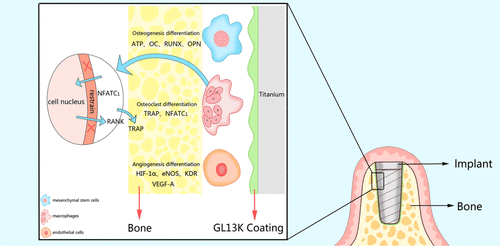当前位置:
X-MOL 学术
›
ACS Biomater. Sci. Eng.
›
论文详情
Our official English website, www.x-mol.net, welcomes your
feedback! (Note: you will need to create a separate account there.)
Regulation of an Antimicrobial Peptide GL13K-Modified Titanium Surface on Osteogenesis, Osteoclastogenesis, and Angiogenesis Base on Osteoimmunology
ACS Biomaterials Science & Engineering ( IF 5.4 ) Pub Date : 2021-08-25 , DOI: 10.1021/acsbiomaterials.1c00639 Lin Zhou 1 , Yu Han 2 , Jiamin Ding 3 , Xuxi Chen 4 , Shiying Huang 5 , Xiaojie Xing 6 , Dong Wu 7 , Jiang Chen 1
ACS Biomaterials Science & Engineering ( IF 5.4 ) Pub Date : 2021-08-25 , DOI: 10.1021/acsbiomaterials.1c00639 Lin Zhou 1 , Yu Han 2 , Jiamin Ding 3 , Xuxi Chen 4 , Shiying Huang 5 , Xiaojie Xing 6 , Dong Wu 7 , Jiang Chen 1
Affiliation

|
Creating a pro-regenerative immune microenvironment around implant biomaterial surfaces is significant to osseointegration. Immune cells, especially macrophages that participate in the osseointegration, including osteogenesis, osteoclastogenesis, and angiogenesis, should be considered when testing biomaterials. In this study, we immobilized an antimicrobial peptide GL13K with immunomodulatory properties onto a titanium surface via silanization. The modified surfaces show good biocompatibility with bone mesenchymal stromal cells (BMSCs), human umbilical vein endothelial cells (HUVECs), and RAW264.7. By co-culturing BMSCs with RAW264.7, we found that the GL13K-coated titanium surfaces could promote late-stage osteogenesis as demonstrated by the upregulated expression of recombinant collagen type I alpha 1 (COL-1α1) and more extracellular matrix mineralization, while the early phase remained unchanged. The surfaces inhibited the osteoclastogenic differentiation of RAW264.7 cells by restraining nuclear factor-activated T cells, cytoplasmic 1 (NFATc1), the main factor of the receptor activator of nuclear factor-κ B, and the receptor activator of the nuclear factor-κ B ligand signaling pathway, from entering the nucleus and further reduced the expression of the activating osteoclastogenic tartrate-resistant acid phosphatase gene. Moreover, the GL13K-coated titanium surface demonstrated significant promotion of angiogenesis differentiation of HUVECs as indicated by the upregulated expression of essential angiogenesis function genes, including hypoxia-inducible factor-1α, endothelial nitric oxide synthase, kinase insert domain receptor, and vascular endothelial growth factor A (HIF-1α, eNOS, KDR, and VEGF-A). Taken together, these results demonstrated that the GL13K coating had properties of osteogenesis, angiogenesis, and anti-osteoclastogenesis via its immunomodulatory potential.
中文翻译:

基于骨免疫学的抗菌肽 GL13K 修饰的钛表面对成骨、破骨细胞生成和血管生成的调节
在植入物生物材料表面周围创建促进再生的免疫微环境对骨整合具有重要意义。在测试生物材料时应考虑免疫细胞,尤其是参与骨整合的巨噬细胞,包括成骨、破骨细胞生成和血管生成。在这项研究中,我们通过硅烷化将具有免疫调节特性的抗菌肽 GL13K 固定在钛表面上。改性表面与骨间充质基质细胞 (BMSC)、人脐静脉内皮细胞 (HUVEC) 和 RAW264.7 显示出良好的生物相容性。通过与 RAW264.7 共培养 BMSCs,我们发现 GL13K 涂层的钛表面可以促进晚期成骨,如重组 I 型胶原蛋白 1 (COL-1α1) 的表达上调和更多的细胞外基质矿化所证明的,而早期阶段保持不变。表面通过抑制核因子激活的 T 细胞、细胞质 1 (NFATc1)、核因子-κB 受体激活剂的主要因子和核因子-κ 受体激活剂来抑制 RAW264.7 细胞的破骨细胞分化B配体信号通路,从进入细胞核进一步降低了活化破骨细胞抗酒石酸酸性磷酸酶基因的表达。而且,GL13K 涂层的钛表面显示出显着促进 HUVEC 的血管生成分化,如必需血管生成功能基因的表达上调,包括缺氧诱导因子 1α、内皮一氧化氮合酶、激酶插入域受体和血管内皮生长因子 A (HIF-1α、eNOS、KDR 和 VEGF-A)。总之,这些结果表明 GL13K 涂层通过其免疫调节潜力具有成骨、血管生成和抗破骨细胞生成的特性。
更新日期:2021-09-13
中文翻译:

基于骨免疫学的抗菌肽 GL13K 修饰的钛表面对成骨、破骨细胞生成和血管生成的调节
在植入物生物材料表面周围创建促进再生的免疫微环境对骨整合具有重要意义。在测试生物材料时应考虑免疫细胞,尤其是参与骨整合的巨噬细胞,包括成骨、破骨细胞生成和血管生成。在这项研究中,我们通过硅烷化将具有免疫调节特性的抗菌肽 GL13K 固定在钛表面上。改性表面与骨间充质基质细胞 (BMSC)、人脐静脉内皮细胞 (HUVEC) 和 RAW264.7 显示出良好的生物相容性。通过与 RAW264.7 共培养 BMSCs,我们发现 GL13K 涂层的钛表面可以促进晚期成骨,如重组 I 型胶原蛋白 1 (COL-1α1) 的表达上调和更多的细胞外基质矿化所证明的,而早期阶段保持不变。表面通过抑制核因子激活的 T 细胞、细胞质 1 (NFATc1)、核因子-κB 受体激活剂的主要因子和核因子-κ 受体激活剂来抑制 RAW264.7 细胞的破骨细胞分化B配体信号通路,从进入细胞核进一步降低了活化破骨细胞抗酒石酸酸性磷酸酶基因的表达。而且,GL13K 涂层的钛表面显示出显着促进 HUVEC 的血管生成分化,如必需血管生成功能基因的表达上调,包括缺氧诱导因子 1α、内皮一氧化氮合酶、激酶插入域受体和血管内皮生长因子 A (HIF-1α、eNOS、KDR 和 VEGF-A)。总之,这些结果表明 GL13K 涂层通过其免疫调节潜力具有成骨、血管生成和抗破骨细胞生成的特性。











































 京公网安备 11010802027423号
京公网安备 11010802027423号